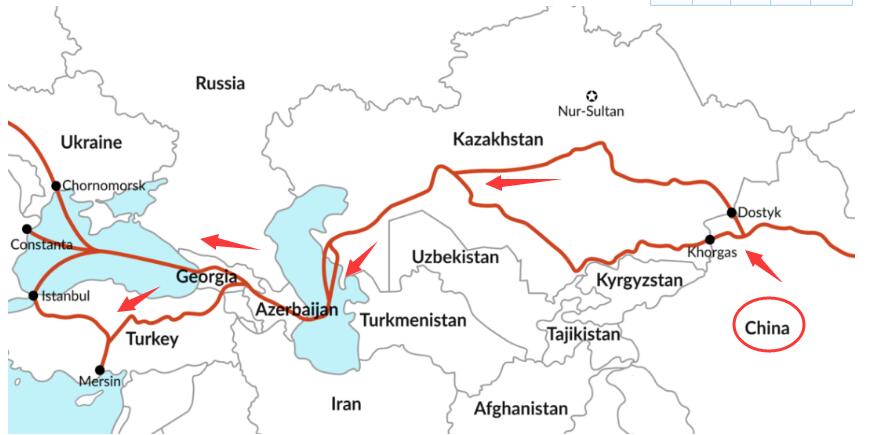What obstacles need to be overcome for the southern route (''Middle corridor '') of China-Europe Block train ?
The southern route (hereafter referred to as the "Middle Corridor") is attracting increasing attention. Of course, there are many people who don't believe in its potential, including shippers, carriers and the media. This transit corridor has been questioned today by The Greek press (Pentapostagma.gr), which basically represents the sceptics' main concerns.
The original text reads as follows:
What really matters is two events. First, the eye-catching agreement reached in early March 2022 between Georgia, Azerbaijan and Kazakhstan on the development of the Trans-Caspian International Transport Route (TITR) calls for the creation of a "Eurasian Railway Union", a tripartite consortium interested in integrating regulations and pushing for lower tariffs on transit goods.
Secondly, the Quadripartite Declaration on the Middle Corridor signed by Georgia, Azerbaijan, Turkey and Kazakhstan underlines the importance of these countries to enhance their transit potential and the advantages of the Trans-Caspian Corridor compared with other routes.
The situation between Russia and Ukraine makes these two agreements more realistic. These countries want to attract international shipping companies into the middle corridor and strengthen their position in the overland trade relationship between China and Europe. Despite these developments, a number of political, economic and technical challenges remain, hindering the possibility of the middle Corridor completely replacing the northern corridor through Russia and Belarus, at least in the short and medium term.
In terms of political challenges, there has so far been no clear support from Chinese or EU governments. Compared with the traditional northern corridor, the middle corridor lacks strong support from the two governments, leaving a question mark over its future development.
At the same time, given China's good relations with Russia, greater Chinese involvement in and support for passages bypassing Russia could be seen by Moscow as a hostile and opportunistic policy. This will affect China's attitude towards the passage. So far, the corridor's future, in the absence of deep involvement from big economies, depends on the policies of transit countries themselves.

In addition to political challenges, economic issues limit the potential of the middle corridor as an alternative.
The first problem is transportation costs. While shipping through the Northern Corridor (via China, Kazakhstan, Russia and Belarus) costs around €2,467 ($2,662) per teU, But freight costs through the middle corridor (China-Kazakhstan - Caspian Sea - Azerbaijan - Georgia - Turkey/Black Sea - Europe) start at 5,000 euros (about $5,400) per teU.
In this regard, many Eurasian companies, including Chinese ones, are reluctant to use the pricier intermediate corridor to ship their products to the EU market due to the lack of subsidies from local governments in China's provinces and cities.
The second problem is shipping time. Although this corridor is the shortest route between China and Europe, the transport time of this route is disadvantageous compared to the traditional northern corridor. It may take five to six days for goods to pass through Russia through the northern corridor, but it takes about 20 to 25 days for goods to pass through the Caspian and Black Sea countries.
The third issue is the business climate. Most of the transit countries of the corridor, particularly Kazakhstan, have an unfriendly business environment. Ineffective border controls in Central Asian countries are increasing the informal cost of transporting goods and lengthening waiting times, one reason Chinese and European companies are reluctant to use the corridor.
The last and most important obstacle is infrastructure and its technological limitations. On the hardware infrastructure side, capacity and capacity are the main obstacles. In 2021, the freight volume of the middle corridor increased by 101 percent year-on-year, but the gap with the capacity of the traditional northern corridor is huge. Transit through Russia, for example, has reached about 1.5m equivalent units (TEUs) per year, compared with an estimated 2-3% of the capacity available in the middle corridor.
The middle corridor requires cargo to be reloaded and reloaded at multiple points, such as two ports on the east and west coasts of the Caspian Sea, and two more reloading stages across the Black Sea.Congestion problems at Caspian and Black Sea ports, lack of operational services at ports, and variable weather conditions can create uncertainties in transportation, causing delays and exacerbating uncertainty in the management of shipping schedules and estimated delivery times.
In addition to the difficulty of crossing the sea, there are also technical obstacles on land. The middle section of the railway from Georgia to Istanbul, Turkey, is still a monorail line with only six freight trains a day. Capacity is limited in areas around Istanbul, such as Gezbe station on the Asian side and Halkali station on the European side. The northern Corridor through Russia can pass through 40 trains a day.
There are also bottlenecks in the software infrastructure. Poor customs and border management, a lack of uniform regulations and technical standards, and lagging digitalization. These problems not only lead to delays, they can also create fertile ground for corruption and fraud at border controls.
This is what Greek media say about the obstacles to the development of the southern route of the China-Europe Freight train. The problem is real.
There's another reality to note, though. Trend.az quoted Temur Umarov, a research expert at the Carnegie Endowment for International Peace Moscow Center, as saying: "Apart from the middle corridor across the Caspian Sea, what other alternatives are worth considering?"